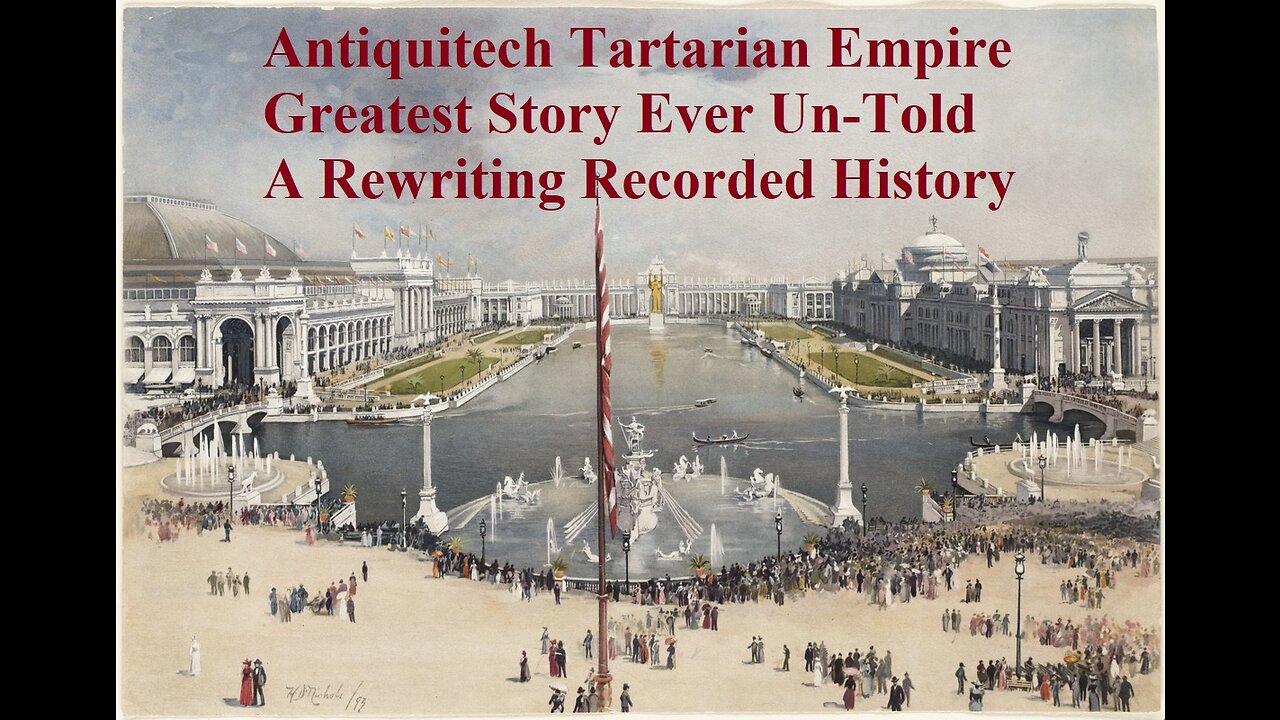Premium Only Content

Antiquitech Tartarian Empire Greatest Story Ever Un-told Rewriting Recorded History
This 1893 World Columbian Exposition In Chicago Is Really A 1,000 Years Old City From Past Antiquitech Tartarian Empire and the True Believers in the “Tartaria” conspiracy theory that 100s of old world fairs 1801 thru 1940 era are convinced that the elaborate temporary fairgrounds built for events like the Panama-Pacific International Exposition in San Francisco in 1915 and 100s of other city were really the ancient capital cities of a fictional empire !
"Expositions are the timekeepers of progress. They record the world's advancement. They stimulate the energy, enterprise, and intellect of the people; and quicken human genius. They go into the home. They broaden and brighten the daily life of the people. They open mighty storehouses of information to the student. Every exposition, great or small, has helped to some onward step." President William McKinley, speaking at the 1901 Pan-American Exposition in Buffalo, NY.
The 1893 World Columbian Exposition in Chicago inaugurated an age of great fairs and expositions in the United States whose influence is felt to this day. The Chicago Exposition and the similar events that followed in Buffalo, NY; St. Louis, MO; Seattle, WA, San Francisco, CA and New York, NY dramatized technology and the fine arts, and illuminated the era ahead, as industrialism took hold, immigration peaked, science moved ever forward, and a vibrant, multi-faceted American music culture grew throughout the country.
Though the 1876 Philadelphia Centennial Exposition in Philadelphia had been a great success, the Chicago Exposition took its immediate inspiration from the Exposition Universelle held in Paris in 1889. Like all previous world's fairs, the Paris exposition hosted music and other entertainment among its exhibits, but in greater variety and on a much larger scale. A major work, Esclarmonde, was commissioned from French composer Jules Massenet and was performed nightly. Music from all over the world was heard, including Javanese gamelan, which was to have a profound effect on composer Claude Debussy. Fairgoers could also hear indigenous music at the village nègre, where some 400 Africans from European colonies spent the duration of the fair demonstrating their culture and crafts. A similarly conceived Algerian Village was also an attraction.
The organizers of the Chicago Exposition would try to match or outdo the 1889 Exposition in every way. For awhile, they even thought of creating a structure taller than the Eiffel Tower built for the 1889 fair, and the tallest building in the world at the time. In the end, they settled for a spectacular city-within-a-city that sprawled over 600 acres and featured 65,000 exhibits. "The White City," so named for its many white buidlings that were made even brighter by the night-time illumination supplied by General Electric, captured the imagination of the country, and drew over 27 million paying customers during its run from May 1st to October 30th, 1893. Within its walls, fairgoers could marvel at the ever-multiplying technological wonders of the age, enjoy art exhibits, concerts and sports; listen to lectures on various topics, view short films in the world's first dedicated movie theater, or ride the original Ferris Wheel.
The Ferris Wheel loomed over the portion of the grounds billed as the "Midway Plaisance," or simply "the Midway," a sort of outdoor arcade 220 yards across that stretched for a mile outside the main fairgrounds in Jackson Park, where rides, music, food, amusements and sideshows of every description were on offer. The "Street in Cairo" exhibit was the most popular of all, drawing more than two million customers to see the first American display of Middle Eastern belly-dancing.
Inside the ‘Tartarian Empire,’ the QAnon of Architecture
On YouTube videos and Reddit boards, adherents of a bizarre conspiracy theory argue that everything you know about the history of architecture is wrong.
In 1908, architect Ernest Flagg completed the Singer Building in Lower Manhattan, a Beaux-Arts showstopper made for the Singer sewing machine company. From a wide base, a slender 27-story tower rose, topped by a mansard roof and a delicate lantern spire.
Every inch dripped with sumptuous detail inside and out; vaulted roofs, marble columns with bronze trim, window mullions with spiral fluting. The lobby was said to have a “celestial radiance.” A book was written just about its construction. For a year, it was the tallest building in the world at 612 feet, and a celebrated landmark for decades after that.
But not for too much longer. Despite its great height, the pencil-thin tower lacked office space. In the 1960s the company sold its ornate headquarters; demolition proceeded in 1967. It’s the tallest building to ever be peacefully demolished.
By any account, it’s a fantastical tale: Once the tallest building in the world and a New York icon, knocked down in just a handful of decades.
For some, it’s too fantastical to believe … or perhaps not fantastical enough. A dedicated group of YouTubers and Reddit posters see the Singer Building and countless other discarded pre-modern beauties and extant Beaux-Arts landmarks as artifacts of a globe-spanning civilization called the Tartarian Empire, which was somehow erased from the history books. Adherents of this theory believe these buildings to be the keys to a hidden past, clandestinely obscured by malevolent actors.
Who? Why? To what possible end? As in many other, more high-profile conspiracy theories, this baroque fantasy doesn’t offer much in the way of practical considerations, logic or evidence. But it’s grounded in some real anxieties, pointing toward the changes wrought by the modern world in general and modern architecture specifically — and rejecting both.
Tartaria rises
Tartarian-themed content is produced for YouTube videos that get picked over on Reddit. The r/Tartarianarchitecture sub, which began in December 2018, has 3,300 members, though not everyone who posts and comments appears to be a true believer. A larger and more general sub that appeared around the same time, r/Tartaria, has 8,700 members. As conspiracy theories go, Tartaria remains obscure; Twitter user cinemashoebox brought it to many people’s attention last year with this thread, and pseudoscience-debunking writer Brian Dunning recently devoted an episode of his podcast, Skeptoid, to the Tartaria theory, which appears to have first emerged in 2016 and 2017.
The Tartaria storyline is not directly related to the adrenochrome-harvesting Satanic-pedophile cabal that lies at the heart of QAnon, the unfounded conspiracy theory that crashed into the real world in 2020. But it shares some of what Peter Ditto, a social psychologist at the University of California-Irvine who specializes in conspiracy theories, calls QAnon’s “cafeteria quality:” There’s no overarching narrative or single authorial voice interpreting events. It’s just a gusher of outlandish speculation; adherents can pick and choose which elements they want to sign on to.
The overall premise is an alternative history. A vast, technologically advanced “Tartarian” empire, emanating from north-central Asia or thereabouts, either influenced or built vast cities and infrastructure all over the world. (Tartaria, or Tartary, though never a coherent empire, was indeed a general term for north-central Asia.) Either via a sudden cataclysm or a steady antagonistic decline — and perhaps as recently as 100 years ago — Tartaria fell. Its great buildings were buried, and its history was erased. After this “great reset,” the few surviving examples of Tartarian architecture were falsely recast as the work of contemporary builders who could never have executed buildings of such grace and beauty, and subjected them to clumsy alterations.
“I think that it was one worldwide civilization,” says Joachim Skaar, a 26-year-old Norwegian who runs The Tartarian Meltdown YouTube channel. “It was all based on unity, oneness, peace, love, and harmony, which we don’t see in today’s society.”
There’s an arch-traditionalism present in the theory, too. The pre-modern buildings that we venerate are sometimes said to be more than 1,000 years old. “The same people that built the Capitol in Washington built the pyramids in Egypt,” Skaar says.
Reached at his recording studio, Skaar, who works as a plumber, is not an architect or historian, but he has strong opinions on both disciplines. “We have two very different types of architecture,” he says. There’s modern architecture “with the name Brutalism,” which he describes as “square concrete boxes which are designed to be produced very fast, very cheap and very effective.”
And then there’s Tartarian architecture, a label that gets applied to anything that’s particularly ornate and pre-modern, encompassing many Western styles: Classical, Beaux-Arts, Second Empire. The term is also sometimes used for some non-Western structures, like the Taj Mahal. Structures that seem geographically or culturally dislocated, like the Beaux-Arts commercial buildings in Shanghai’s Bund district, are particularly attractive to this theory, as are those that are impressively massive, like the pyramids of Egypt or the Great Wall of China (built, the theory goes, by Tartarians to keep the Chinese out). Anywhere there’s a perceived gap between the refined craftwork of an old building and the “primitive” technology of the horse-and-buggy-era people building it, space for Tartarian speculation pops up.
American cities of the 19th century are often rich with Tartarian appropriation, especially the young settlements of the West, when grand public structures seemed to emerge from the wilderness, surrounded by wood hovels and muddy streets. State capitol buildings and city halls are frequently fingered as palaces of ancient Tartaria rather than Gilded Age municipal buildings. (These photos of the Iowa State Capitol in Des Moines highlight the contrast Tartarian theorists point out.)
The Tartarian milieu is an intensely visual medium, occupied with riffing on photos and maps, picking out apparent inconsistencies and making one-off conjectures instead of weaving together comprehensive timelines. The theory is notably light on reasoning as to why and how the greatest cover-up in history was undertaken, but it does offer a few options for how Tartaria was erased and the great reset propagated. Many say that an apocalyptic mud flood buried its great buildings; some suggest the use of high-tech weaponry to tactically remove Tartarian infrastructure. A consistent theme is that warfare is an often-used pretext to wipe away surviving traces of Tartarian civilization, with the two world wars of the 20th century finishing work that may have begun with Napoleon’s invasion of Russia.
Despite their interest in architecture, most Tartaria theorists do not appear to have backgrounds in the building trades: Many of the more easily refuted arguments spring from very basic misunderstandings of how the built environment works, as well as broader confusion about how buildings function in the economy and culture. An abundance of posters appear convinced that below-grade basement windows in older buildings, for example, are evidence that the building had been “mud flooded,” and the rest of the structure is actually buried deep underground. Sometimes this will get some skeptical pushback (“I think they didn't have lights in the cellar so they build in windows for them?” was how one poster responded), but that’s more of an exception than the rule.
“You see these capital domes all over the world, which, to me, proves that the same people built everywhere.”
Similarly, their grasp of historic labor and material costs is shaky. Before the Industrial Revolution, labor was cheap, so paying artisans to sculpt elaborate masonry — even for relatively humble structures — wasn’t the great expense it seems today, when labor prices are higher and factory-made steel, concrete and glass is cheap; that’s why we see so much of these materials in buildings today, and so much less filigreed terra cotta. One of the most adamant denials in Tartarian circles is that public buildings like schools and post offices were ever built with monumental proportions and elegant aesthetics. They sneer at the wedding-cake-topper Second Empire buildings designed by Alfred Mullett after the Civil War, for example. “How many stamps did you sell to build yourself a post office like this?,” says popular Tartarian YouTuber JonLevi in one of his videos. “Absolutely ridiculous. The post office has always struggled.” (He has more than 100,000 subscribers.)
Some of this confusion is unfamiliarity: Mullett’s U.S. Customs House and Post Office in St. Louis, for example, was a huge federal project, built to process the mail of 10 states and four U.S. territories, not a neighborhood letter depot. But beyond that, there’s a broader refusal to believe that public architecture could ever have been built in an atmosphere of generosity and abundance. This is echoed by their astonishment at the double-height grand lobbies and arched doorways of old buildings, which they see as artifacts not meant for us. (Some theorists surmise that ancient Tartarians were giants.) The Tartarian community seems to have internalized the current era’s predilection for public sector austerity and the resulting aesthetics, which they abhor, more than they realize.
At its core, the theory reflects a fear of how quickly things change. As they look at today’s cityscapes, Tartaria believers see an eerie and alienating place, filled with abstract monoliths that emerged out of nowhere in a brief period of time. They’re skeptical of the rapid rise and development of the U.S., and even more suspicious of how quickly Modernism came to dominate the landscape. One favorite case study, useful for illustrating this aesthetic whiplash, is the grand domed Henry Ives Cobb Chicago Federal Building, built in 1905. Like the Singer Building, it was razed after just 60 years in favor of an icy black Mies van Der Rohe tower.
In one sense, the Tartaria theory is right: With modern architecture, a revolutionary new consensus on how the built environment should look and work did take hold in a very short period of time, conveniently overlapping with the world wars that these theorists see as the tail end of Tartaria’s influence. The world of 1960 indeed looked radically different from the world of 1920. Led by obscure and poorly understood forces (architects), architecture schools truly did throw out the history books to build a new world. But instead of making this excision the work of a colossal global mega-conspiracy worthy of a pulpy airport mystery novel, they wouldn’t shut up about it.
In the Tartarian worldview, we’re a society that doesn’t properly understand or value the built environment, because we’ve been misled about who really built it. When he’s decrying the lack of regard for the cultural legacy of old buildings, Skaar sounds less like a conspiracy theorist than a board member of a preservation nonprofit. “The problem is that people don’t recognize these buildings,” he says. “They walk past them all the time, and they’re fascinated, but they don’t think any more deeply about it. They don’t know what they’re looking at because they have been told something else.”
In search of a fabricated empire
This disregard for architecture’s “true” history moves into a wider rejection of how disposably cheap and commodified the culture at large seems to be. As such, one canonical belief of Tartarian aficionados is that the elaborate temporary pavilions built for late 19th century and early 20th century World’s Fairs were in fact Tartarian capital cities. It strikes them as improbably wasteful that anyone would erect these magnificent complexes, full of fluted columns, domes and pediments, out of plaster of Paris, hemp fiber, and straw, as was done for the 1893 World’s Fair in Chicago. In Tartarian lore, these sites were ancient monuments that were co-opted to teach a falsified history of the world and make a few bucks selling popcorn and Ferris Wheel rides. Then they were demolished, to erase the handiwork of the real builders.
In pointing out the eradication of an ancient culture by an expanding imperial power, Tartarian believers again stumble on something real, but they scramble the protagonists. In the European colonial era, Western nations fanned out over the globe, subjugating and destabilizing numerous non-white civilizations — and building many examples of what’s now considered Tartarian architecture as celebration of these victories. But when YouTuber JonLevi marvels at the Hong Kong Shanghai Bank and the rest of the 1920s banking infrastructure built along Shanghai’s Huangpu River, he doesn’t see the wealth-extracting handiwork of a rapacious 20th century empire: In the Tartaria-verse, these are the stately remnants of a far older and more benevolent one. The theory posits that only Tartarians, not British bankers or Belgian rubber barons, could move culture like architecture across geography.
“You see these capital domes all over the world, which, to me, proves that the same people built everywhere,” says Skaar.
Bastion star forts are another building type that Tartarians are obsessed with: They often point out that these cannon-resistant military fortifications, popular in the 16th and 17th centuries, are found all over Western Europe, like Portugal and the Netherlands, but also quite mysteriously, far away in Asia, in Sri Lanka. But since Sri Lanka was a Portuguese and Dutch colony, it’s not really very mysterious. Military historian Jeremy Black, author of two books on the history of fortifications, says that the geographic reoccurrence of the style reflects how effective Europeans were in spreading this technology across the globe.
This ahistoricism can make the Tartarian architecture community occasionally receptive to reactionaries, racists and anti-Semites. A survey of videos and discussions will turn up all manner of other conspiratorial threads. Along with flat-Earth advocacy, anti-vaccination sentiments and 5G scaremongering, there’s talk of anti-Semitic banking cartel conspiracies and Holocaust denial. Some Tartarian histories recast populations of Central Asia, like Genghis Kahn’s Mongol Empire, as red-haired, blue-eyed, white people — “Silk Road Aryans.”
The persistence of anti-Jewish tropes within current conspiracy theories is likely the result of cultural inertia, says UC-Irvine scholar Ditto. As successive generations of the conspiracy-minded seek evidence to back up their diverging worldview, they find it in texts that may go back centuries, which are riddled with anti-Semitism.
But the face of the villains in the Tartarian narrative is not clearly defined. Skaar blames quasi-mystical “parasites” who thrive off pain and strife, and laments that contemporary life has become a place where “everything is based on tyranny, greed, and slavery.” The Tartaria commentariat is laced with economic discontent; they often decry the evaluation and disregard of buildings purely as salable commodities, untethered from broader notions of cultural legacy and achievement. There’s a reoccurring and implicit understanding that buildings, like the Singer Building, get torn down when they stop making money — the only thing that really matters — and that the world is a vast field of predation, where the rich and powerful consume the poor and weak.
In fact, the governing ideology of the modern architecture that Tartarians despise was a critique of this system. Modernism argued for an egalitarian architecture that would help break the shackles of the past, rejecting backbreaking representational craftsmanship to honor omnipotent kings and divine beings in favor of simple, universal forms that would leverage restraint and efficacy into a broad uplift for the masses. Minus the weirdest stuff — the global mud flood, the ancient energy weapons, the vanished race of giants — the Tartaria theory is just an extreme form of aesthetic moralism, the idea that traditional architecture styles are inherently good and modern architecture is the product of a degenerate culture.
The tastes of the community generally align with traditional architectural revival proponents (some of whom also embrace reactionary and white nationalist politics). This sort of aesthetic nativism flourished during the Trump era, and it appears to have fresh converts in Congress: Recently, representatives Marjorie Taylor Greene and Paul Gosar formed a new caucus dedicated to “uniquely Anglo-Saxon political traditions” and infrastructure that “befits the progeny of European architecture.” The language is different, but the sentiment wouldn’t appear out of place in r/Tartaria.
Holding back a flood of conspiracies
Though the Tartarian Empire seemed to wink into existence in the past few years, the themes its believers explore are familiar ones. Conspiracy theories are a way to channel restive populism in the face of rapid social and demographic change, Ditto says, and there’s plenty of that going around. They are also a way to gather up amorphous fears and put them in a specific place, to make them more manageable. Ditto calls this “over-intentionalization.
“If your fate is controlled by impersonal, systemic forces, it doesn’t offer you much control over your own destiny,” he says. “But if you can localize it to a small group of people whose motives you understand — they are out to get you — then it at least offers some hope that you can overcome their malevolent intentions.”
Belief in conspiracy theories can also be driven by loneliness, isolation and economic hardship, which made a pandemic a fertile Petri dish, and helped QAnon’s believers storm the Capitol by force and through the ballot box. The social atomization forced on us by Covid-19 is a hyperbolic retelling of the Tower of Babel (which has a special place in Tartarian lore) and its attendant anxiety at fracturing and divided cultures. The great reset that erased that tower — and the fabulous, fictional empire that built it — continues to reverberate, splintering us into ever-stranger factions.
And Ditto says it does seem like reality is getting harder to decipher. The internet has made it easier to disseminate misinformation while eroding faith in the media hierarchies that once filtered it out. Polarization and a lack of trust in government and institutions creates a feedback loop, where leaders can’t solve problems because their political bases are too narrow, and the resulting failures engender more distrust. It’s not a new cycle — despite a spike in media attention, there’s not much evidence that conspiratorial thinking is more common now than in years past — but technology can make these currents of collective delusion more powerful, and harder to ignore.
The basic human desires for community, stories (the more outrageous the better) and the need to feel like a protagonist in a wider struggle are what pulls us from moments of real social, economic and cultural dislocation into fabricated histories. Buildings and cities are made to grow old, to outlast people, and to be a testament to these cultural histories. They’re a yardstick for a culture’s ability to endure. When they’re not given the chance to do this, the contradiction can break something loose, and send people scavenging for cultural memory that feels ancient enough to anchor them in an uncertain now.
This is a chronological list of international or colonial world's fairs.
https://en.wikipedia.org/wiki/List_of_world's_fairs
All elaborate temporary fairgrounds built are removed after the fair is over.
1790s
1791 – Prague, Bohemia – first industrial exhibition on the occasion of the coronation of Leopold II as king of Bohemia, took place in Clementinum, considerable sophistication of manufacturing methods. For this occasion, Wolfgang Amadeus Mozart wrote his final opera La clemenza di Tito.
1798 – Paris, France – L'Exposition des produits de l'industrie française, Paris, 1798. This was the first public industrial exposition in France although earlier in 1798 the Marquis d'Avèze had held a private exposition of handicrafts and manufactured goods at the Maison d'Orsay in the Rue de Varenne and it was this that suggested the idea of a public exposition to Nicolas François de Neufchâteau, Minister of the Interior for the French Republic.
1800s
1801 – Paris, France – Second Exposition (1801). After the success of the exposition of 1798 a series of expositions for French manufacturing followed (1801, 1802, 1806, 1819, 1823, 1827, 1834, 1844 and 1849) until the first properly international (or universal) exposition in France in 1855.
1802 – Paris, France – Third Exposition (1802)
1806 – Paris, France – Fourth Exposition (1806)
1810s
1819 – Paris, France – Fifth Exposition (1819)
1820s
1823 – Paris, France – Sixth Exposition (1823)
1827 – Paris, France – Seventh Exposition (1827)
1829 – New York City, United States – American Institute Fair
1829 – Turin, Piedmont-Sardinia – Prima Triennale Pubblica Esposizione dell’anno 1829. In Turin, a second 'triennale' followed in 1832 before other national agricultural, industrial, commercial, and applied arts expositions there in 1838, 1844, 1850 and 1858.
1830s
1832 – Turin, Piedmont-Sardinia – Seconda Triennale Pubblica Esposizione dell’anno 1832.
1834 – Paris, France – French Industrial Exposition of 1834
1838 – Turin, Piedmont-Sardinia – Pubblica esposizione dell'anno 1838.
1839 – Paris, France – Ninth Exposition (1839)
1840s
1844 – Paris, France – French Industrial (Tenth) Exposition of 1844
1844 – Turin, Piedmont-Sardinia – Quarta Esposizione d'Industria et di Belle Arti.
1846 – Genoa, Piedmont-Sardinia – Esposizione dei Prodotti e delle Manufatture nazionali
1849 – Birmingham, United Kingdom – Exhibition of Industrial Arts and Manufacturers
1849 – London, United Kingdom – First Exhibition of British Manufacturers (1849)
1849 – Paris, France – Eleventh Exposition (1849)
1850s
1850 – Turin, Piedmont-Sardinia – Quinta Esposizione di Industria e di Belle Arti
1851 – London, United Kingdom – The Great Exhibition of the Works of Industry of All Nations – The Crystal Palace (typically listed as the "first world's fair")
1852 – Cork, Ireland – Irish Industrial Exhibition
1853 – Naples, Two Sicilies – Solenne Pubblica Esposizione di Arti e Manifatture
1853–1854 – New York City, United States – Exhibition of the Industry of All Nations
1853 – Dublin, Ireland – Great Industrial Exhibition (1853)
1854 – Genoa, Piedmont-Sardinia – Esposizione Industriale
1854 – Munich, Bavaria – General German Industrial Exhibition (Allgemeine deutsche Industrie-Ausstellung)
1854 – Melbourne, Victoria – Melbourne Exhibition (in conjunction with Exposition Universelle (1855)
1855 – Paris, France – Exposition Universelle (1855)
1856 – Brussels, Belgium – International Exhibition
1857 – Manchester, United Kingdom – Art Treasures Exhibition at the Royal Botanical Gardens, Stretford
1857 – Lausanne, Switzerland – Lausanne Exhibition
1858 – Dijon, France – Dijon Exposition
1858 – Philadelphia, Pennsylvania, United States – Philadelphia Technological Exhibition
1858 – Turin, Piedmont-Sardinia – Sesta Esposizione Nazionale di Prodotti d'Industria
1860s
1860 – Montreal, Quebec, Canada - Grand Exhibition of the Industrial Products of United Canada at the Crystal Palace (Montreal)
1861 – Brisbane, Queensland – First Queensland Exhibition
1861 – Melbourne, Victoria – Second Victorian Exhibition
1861 – Metz, France – Exposition Universelle (1861)
1861 – Amsterdam, Netherlands – Fisheries Exposition
1862 – Geelong, Victoria - Exhibition of Art, Science and Industry
1862 – London, United Kingdom – 1862 International Exhibition
1864 – Bayonne, France – Franco-Spanish Exposition
1865 – Cologne, Prussia – International Agricultural Exhibition
1865 – Bergen, Norway – International Fisheries Exhibition
1865 – Batavia, Dutch East Indies – Industrial and Agricultural Exhibition
1865 – Dunedin, New Zealand – New Zealand Exhibition
1865 – Dublin, United Kingdom – International Exhibition of Arts and Manufactures
1865 – Freetown, Sierra Leone – Sierra Leone Exhibition
1865 – Porto, Portugal – 1865 International Exhibition
1866 – Ballarat, Victoria – National Industrial Exhibition
1866 – Melbourne, Victoria – Intercolonial Exhibition of Australasia
1866 – Boulogne-sur-Mer, France – International Fisheries Exposition
1866 – Arcachon, France – International Exposition of Fish and Water Products
1866 – Stockholm, Sweden – Scandinavian Industrial Exhibition
1867 – Paris, France – Exposition Universelle (1867)
1867 – The Hague, Netherlands – International Maritime Exhibition
1867 – Aarhaus, Denmark – International Maritime Exhibition
1867 – Vienna, Austria – International Maritime Exhibition
1867 – Gothenburg, Sweden – International Maritime Exhibition
1868 – Le Havre, France – International Maritime Exposition
1869 – Amsterdam, Netherlands – International Exhibition of Domestic Economy
1870s
1870 – Sydney, New South Wales – Intercolonial Exhibition (1870)
1871 – Córdoba, Argentina – Exposición Nacional
1871 – London, United Kingdom – First Annual International Exhibition (1871)
1871 – Naples, Italy – International Maritime Exposition
1872 – Hamilton, Bermuda – Industrial and Loan Exhibition
1872 – Copenhagen, Denmark – Second Scandinavian Exhibition of Arts and Industry
1872 – London, United Kingdom – Second Annual International Exhibition (1872)
1872 – Christchurch, New Zealand – New Zealand Interprovincial Exhibition
1872 – Lima, Peru – Lima International Exhibition
1872 – Lyon, France – Exposition Universelle et Internationale (1872)
1872 – Kyoto, Japan – Exhibition of Arts and Manufactures (1872)
1873 – London, United Kingdom – Third Annual International Exhibition (1873)
1873 – Vienna, Austria – Weltausstellung 1873 Wien
1873 – Sydney, New South Wales – Metropolitan Intercolonial Exhibition (1873)
1874 – London, United Kingdom – Fourth Annual International Exhibition (1874)
1874 – Dublin, United Kingdom – International Exhibition of Arts and Manufactures (1874)
1874 – Rome, Italy – Esposizione internazionale (1874) (never held)
1874 – Jamestown, Saint Helena – St. Helena Industrial Exhibition
1874 – Marseille, France – Exhibition of Modern Inventions and Discoveries
1874 – Philadelphia, Pennsylvania, United States – Franklin Institute Exhibition
1875 – Melbourne, Victoria – Victorian Intercolonial Exhibition
1875 – Nizhni Novgorod, Russia – Nizhni Novgorod Fair (1875)
1875 – Sydney, New South Wales – Intercolonial Exhibition (1875)
1875 – Santiago, Chile – Chilean International Exhibition
1876 – Brussels, Belgium – International Exposition of Hygiene and Life-saving Apparatus
1876 – Helsinki, Finland – Finnish General Exhibition
1876 – Adelaide, South Australia – Adelaide Industrial Exhibition
1876 – Philadelphia, Pennsylvania, United States – Centennial Exposition
1876 – Brisbane, Queensland – Intercolonial Exhibition (1876)
1876 – London, United Kingdom – London Loan Collection of Scientific Apparatus
1877 – Cape Town, Cape Colony – South African International Exhibition
1877 – Tokyo, Japan – First National Industrial Exhibition (1877) (Ueno Park)
1877 – Sydney, New South Wales – Sydney Metropolitan and Intercolonial Exhibition
1877 – Adelaide, South Australia – Adelaide Industrial Exhibition
1878 – Paris, France – Exposition Universelle (1878)
1878 – Ballarat, Victoria – Australian Juvenile Industrial Exhibition (1878)
1878 – London, United Kingdom – International Fisheries Exhibition
1879 – Bendigo, Victoria – Juvenile Industrial Exhibition
1879 – Geelong, Victoria – Geelong Juvenile and Industrial Exhibition
1879 – Sydney, New South Wales – Intercolonial Juvenile Industrial Exhibition
1879 – Sydney, New South Wales – Sydney International Exhibition
1879 – Melbourne, Victoria – Intercolonial Juvenile Industrial Exhibition (1879)
1879 – Kilburn, United Kingdom – International Agricultural Exhibition
1880s
1880 – Berlin, Germany – International Fisheries Exhibition
1880 – Christchurch, New Zealand – Christchurch Industrial Exhibition
1880 – Adelaide, South Australia – Industrial and Juvenile Exhibition
1880 – Glasgow, United Kingdom – Glasgow Electrical Exhibition
1880-1881 – Melbourne, Victoria – Melbourne International Exhibition (1880)
1881 – Adelaide, South Australia – Adelaide Exhibition.
1881 – Matanzas, Cuba – Exhibition of Matanzas
1881 – Milwaukee, Wisconsin – Milwaukee Industrial Exposition
1881 – Paris, France – International Exposition of Electricity, Paris
1881 – Dunedin, New Zealand – Dunedin Industrial Exhibition
1881 – Atlanta, Georgia, United States – International Cotton Exposition
1881 – Budapest, Austria-Hungary – Országos Nőipari Kiállitás
1881 – London, United Kingdom – International Medical and Sanitary Exhibition
1881 – Tokyo, Japan – Second National Industrial Exhibition
1881-1882 – Perth, Western Australia – Perth International Exhibition
1882 – Lille, France – International Exposition of Industrial Art
1882 – Munich, Germany – International Electrical Exposition
1882 – Christchurch, New Zealand – New Zealand International Exhibition
1882 – London, United Kingdom – Crystal Palace Electric Exhibition
1882 – Edinburgh, United Kingdom – International Fisheries Exhibition
1882 – Bordeaux, France – Exposition internationale des vins
1882 – Buenos Aires, Argentina – South American Continental Exhibition (Exposición Continental Sud-Americana)
1883 – London, United Kingdom – International Electric Exhibition
1883 – Vienna, Austria-Hungary – International Electrical Exposition
1883 – Cork, United Kingdom – Cork Industrial Exhibition
1883 – Amsterdam, Netherlands – International Colonial and Export Exhibition
1883 – Calcutta, India – Calcutta International Exhibition
1883 – Marseilles, France – International Maritime Exposition
1883 – Christchurch, New Zealand – All Colonial Exhibition
1883 – Madrid, Spain – Exposition of Mining and Metallurgy
1883 – South Kensington, United Kingdom – International Fisheries Exhibition
1883 – Parramatta, New South Wales – Intercolonial Juvenile Industrial Exhibition
1883 – Hobart, Tasmania – Tasmanian Juvenile and Industrial Exhibition
1883 – Launceston, Tasmania – Art and Industrial Exhibition
1883 – Louisville, Kentucky, United States – Southern Exposition
1883 – New York City, United States – World's Fair (1883) (never held)
1883 – Caracas, Venezuela – National Exposition of Venezuela
1883–1884 – Boston, Massachusetts, United States – The American Exhibition of the Products, Arts and Manufactures of Foreign Nations
1884 – Nice, France – International Exposition of Nice
1884 – Amsterdam, Netherlands – International Agricultural Exhibition
1884 – London, United Kingdom – London International Universal Exhibition
1884 – South Kensington, United Kingdom – International Health and Education Exhibition
1884 – Cape Town, Cape Colony – South African Industrial Exhibition
1884 – Durban, South Africa – Natal Agricultural, Horticultural, Industrial and Art Exhibition
1884 – New Orleans, Louisiana, United States – World Cotton Centennial
1884 – Melbourne, Victoria[30] – Victorian International Exhibition 1884 of Wine, Fruit, Grain & other products of the soil of Australasia with machinery, plant and tools employed
1884 – Edinburgh, United Kingdom – First International Forestry Exhibition
1884 – Turin, Italy – Esposizione Generale Italiana
1884 – Adelaide, South Australia – Grand Industrial Exhibition
1885 – Melbourne, Victoria – Victorians' Jubilee Exhibition (1885) (Jubilee of Victoria Exhibition)
1885 – Port Elizabeth, Cape Colony (now South Africa) – South African Exhibition
1885 – Antwerp, Belgium – Exposition Universelle d'Anvers (1885)
1885 – Nuremberg, Germany – International Exposition of Metals and Metallurgy
1885 – Budapest, Hungary – Hungarian National Exhibition
1885 – Wellington, New Zealand – New Zealand Industrial Exhibition
1885 – Zaragoza, Spain – Aragonese Exposition
1885 – London, United Kingdom – International Inventions Exhibition
1886 – London, United Kingdom – Colonial and Indian Exhibition (1886)
1886 – Edinburgh, United Kingdom – International Exhibition of Industry, Science and Art
1886 – Liverpool, United Kingdom – International Exhibition of Navigation, Commerce and Industry (1886)
1886 – Bendigo, Victoria – Juvenile and Industrial Exhibition
1886 – Launceston, Tasmania – Launceston Industrial Exhibition
1886 – Perth, Western Australia – West Australian Exhibition
1887 – Le Havre, France – International Maritime Exposition
1887 – Atlanta, United States – Piedmont Exposition
1887 – Geelong, Victoria – Geelong Jubilee Juvenile and Industrial Exhibition (1887)
1887 – Manchester, United Kingdom – Royal Jubilee Exhibition
1887 – London, United Kingdom – American Exhibition
1887 – Newcastle, United Kingdom – Royal Mining Engineering Jubilee Exhibition
1887 – Rome, Italy – Esposizione mondiale (1887)
1887 – Madrid, Spain – Exposición General de las Islas Filipinas
1887–1888 – Adelaide, South Australia – Adelaide Jubilee International Exhibition (1887)
1888 – Glasgow, United Kingdom – International Exhibition (1888)
1888 – Brussels, Belgium – Grand Concours International des Sciences et de l'Industrie (1888)
1888 – Barcelona, Spain – Exposición Universal de Barcelona (1888)
1888 – Cincinnati, Ohio – Cincinnati Centennial Exposition (1888)
1888 – Lisbon, Portugal – Exposição Industrial Portugueza (1888)
1888 – Copenhagen, Denmark – The Nordic Exhibition of 1888 (Nordiske Industri-Landbrugs og Kunstudstilling)
1888–1889 – Melbourne, Victoria – Melbourne Centennial Exhibition
1888–1889 – Melbourne, Victoria – Victorian Juvenile Industrial Exhibition (1888)
1889 – Paris, France – Exposition Universelle (1889) – Eiffel Tower
1889 – Dunedin, New Zealand – New Zealand and South Seas Exhibition (1889)
1889 – Buffalo, New York, United States – International Industrial Fair (1889)
1890s
1890 – Buenos Aires, Argentina – Agricultural Exhibition
1890 – Vienna, Austria-Hungary – Agricultural and Forestry Exposition
1890 – Bremen, Germany – Nord-West-Deutsche Gewerbe und Industrie-Ausstellung
1890 – London, United Kingdom – International Exhibition of Mining and Metallurgy
1890 – Edinburgh, United Kingdom – International Exhibition of Science, Art & Industry
1890 – Ballarat, Victoria - Australian Juvenile Industrial Exhibition
1891 – Moscow, Russia – Exposition française
1891 – Frankfurt, Germany – International Electrotechnical Exhibition
1891 – Kingston, Jamaica – International Exhibition (1891)
1891 – Prague, Austria-Hungary – General Land Centennial Exhibition (1891) at the Prague Exhibition Grounds
1891 – Adelaide, South Australia – Industrial Exhibition of South Australian Industries, Products and Manufactures
1891 – Port of Spain – Trinidad and Tobago Exhibition
1891–1892 – Launceston, Tasmania – Tasmanian International Exhibition (1891)
1892 – Grenoble, France – International Alpine Exposition of Grenoble
1892 – Genoa, Italy – Esposizione Italo-Americana (1892)
1892 – Washington, D.C., United States – Exposition of the Three Americas (1892) (never held)
1892 – London, United Kingdom – Crystal Palace Electrical Exhibition
1892 – Kimberley, Cape of Good Hope – South African and International Exhibition
1892–1893 – Madrid, Spain – Historical American Exposition
1893 – Chicago, Illinois, United States – World's Columbian Exposition – Palace of Fine Arts and the World's Congress Auxiliary Building
1893 – New York City, United States – World's Fair Prize Winners' Exposition (1893)
1894 – San Francisco, California, United States – California Midwinter International Exposition of 1894
1894 – Antwerp, Belgium – Exposition Internationale d'Anvers (1894)
1894 – Santiago, Chile – International Mining and Metallurgical Exposition
1894 – Lyons, France – Exposition internationale et coloniale
1894 – Manchester, United Kingdom – British and Colonial Exhibition
1894 – Porto, Portugal – Exposição Insular e Colonial Portugueza (1894)
1894 – Fremantle, Western Australia – Fremantle Industrial Exhibition
1895 – Adelaide, South Australia – Exhibition of Art and Industry
1895 – Hobart, Tasmania – Tasmanian International Exhibition (1895)
1895 – Ballarat, Victoria – Australian Industrial Exhibition (1895)
1895 – Bordeaux, France – Bordeaux Exposition
1895 – Kyoto, Japan – National Japanese Exhibition
1895 – Christchurch, New Zealand – Art and Industrial Exhibition
1895 – Atlanta, Georgia, United States – Cotton States and International Exposition (1895) (Atlanta Exposition)
1895 – Montevideo, Uruguay - National Agricultural Exhibition
1896 – Rouen, France – National and Colonial Exposition
1896 – Kiel, Germany – International Shipping and Fishery Exposition
1896 – Budapest, Austria-Hungary – Hungarian Millenary Exhibition
1896 – Wellington, New Zealand – Wellington Industrial Exhibition
1896 – Nizhny Novgorod, Russia – Pan Russian Exhibition
1896 – Malmö, Sweden – Nordic Industrial and Handicraft Exhibition
1896 – Berlin, Germany – Great Industrial Exposition of Berlin
1896 – Mexico City, Mexico – International Exposition (1896) (never held)
1896 – Cardiff, United Kingdom – Cardiff Fine Arts, Industrial, and Maritime Exhibition
1897 – Brussels, Belgium – Exposition Internationale de Bruxelles (1897)
1897 – Arcachon, France – Arcachon International Exposition
1897 – Guatemala City, Guatemala – Exposición Centroamericana
1897 – London, United Kingdom – Imperial Victorian Exhibition
1897 – Brisbane, Queensland – Queensland International Exhibition
1897 – Chicago, Illinois, United States – Irish Fair (1897)
1897 – Nashville, Tennessee, United States – Tennessee Centennial and International Exposition
1897 – Stockholm, Sweden – General Art and Industrial Exposition of Stockholm
1897 – Kiev, Russian Empire – Agricultural Exhibition
1898 – Buenos Aires, Argentina – National Exhibition
1898 – Jerusalem, Ottoman Empire – Universal Scientific and Philanthropic Exposition (1898)
1898 – Auckland, New Zealand – Auckland Industrial and Mining Exhibition
1898 – Dunedin, New Zealand – Otago Jubilee Industrial Exhibition (1898)
1898 – Omaha, Nebraska, United States – Trans-Mississippi Exposition
1898 – Bergen, Norway – International Fisheries Exposition (1898)
1898 – Munich, Germany – Kraft – und Arbeitsmaschinen-Ausstellung (1898)
1898 – San Francisco, California, United States – California's Golden Jubilee (1898)
1898 – Turin, Italy – Esposizione Generale Italiana
1898 – Vienna, Austria-Hungary – Jubiläums-Ausstellung
1898 – Launceston, Tasmania – Tasmanian Juvenile Industrial Exhibition
1898 – Grahamstown, South Africa – Industrial and Arts Exhibition
1899 – Coolgardie, Western Australia – Western Australian International Mining and Industrial Exhibition
1899 – Como, Italy – Como Electrical Exhibition
1899 – Omaha, Nebraska, United States – Greater America Exposition
1899 – Philadelphia, Pennsylvania, United States – National Export Exposition
1899 – London, United Kingdom – Greater Britain Exhibition
1900s
1900 – Paris, France – Exposition Universelle (1900)[68] – Le Grand Palais
1900 – Adelaide, South Australia – Century Exhibition of Arts and Industries (1900)
1900 – Christchurch, New Zealand – Canterbury Jubilee Industrial Exhibition
1901 – Bendigo, Australia – Victorian Gold Jubilee Exhibition
1901 – Buffalo, New York, United States – Pan-American Exposition
1901 – Glasgow, United Kingdom – Glasgow International Exhibition (1901)
1901 – Vienna, Austria-Hungary – Bosnische Weihnachts-Ausstellung (1901)
1901 – Charleston, South Carolina, United States – South Carolina Inter-State and West Indian Exposition
1902 – Vienna, Austria-Hungary – International Fishery Exposition
1902 – Turin, Italy – Esposizione Internazionale d'Arte Decorativa Moderna
1902 – Hanoi, French Indochina – Hanoi exhibition (Indo China Exposition Française et Internationale)
1902 – Lille, France – International Exposition of Lille
1902 – Cork, United Kingdom – Cork International Exhibition
1902 – Wolverhampton, United Kingdom – Wolverhampton Art and Industrial Exhibition
1902 – St. Petersburg, Russia – International Fisheries Exhibition
1902 – New York City, United States – United States, Colonial and International Exposition (1902) (never held)
1902 – Toledo, Ohio, United States – Ohio Centennial and Northwest Territory Exposition (1902) – (never held)
1903 – Melbourne, Australia – Australian Federal International Exhibition
1903 – Osaka, Japan – Fifth National Industrial Exhibition
1904 – St. Louis, Missouri, United States – Louisiana Purchase Exposition (also called Louisiana Purchase International Exposition and Olympic Games ): 1904 Summer Olympics
1904 – Cape Town, South Africa – Cape Town Industrial Exhibition
1905 – Portland, Oregon, United States – Lewis and Clark Centennial Exposition
1905 – Liège, Belgium – Exposition universelle et internationale de Liège (1905)
1905 – London, United Kingdom – Naval, Shipping and Fisheries Exhibition
1905 – New York City, United States – Irish Industrial Exposition (1905)
1906 – Vienna, Austria-Hungary – Hygiene Exhibition
1906 – Milan, Italy – Esposizione Internazionale del Sempione
1906 – London, United Kingdom – Imperial Austrian Exhibition
1906 – Marseille, France – Exposition coloniale (1906)
1906 – Bucharest, Romania – Romanian General Exposition
1906 – Tourcoing, France – International Exposition of Textile Industries
1906–1907 – Christchurch, New Zealand – International Exhibition (1906)
1907 – Bordeaux, France – International Maritime Exposition
1907 – Tokyo, Japan – Tokyo Industrial Exhibition
1907 – Bergen, Norway – Nordic Marine Motor Exhibition
1907 – Dublin, United Kingdom – Irish International Exhibition
1907 – Hampton Roads, Virginia, United States – Jamestown Exposition
1907 – Chicago, Illinois, United States – World's Pure Food Exposition (1907)
1907 – Mannheim, Germany – Internationale Kunst-Ausstellung (1907)
1908 – Marseille, France – Exposition of Electricity
1908 – Trondheim, Norway – Scandinavian Fisheries Exhibition
1908 – Zaragoza, Spain – Hispano-French Exposition of 1908
1908 – London, United Kingdom – Franco-British Exhibition (1908)
1908 – Edinburgh, United Kingdom – Scottish National Exhibition
1908 – New York City, United States – International Mining Exposition (1908)
1908 – Rio de Janeiro, Brazil – Exhibition of the centenary of the opening of the Ports of Brazil
1908 – Marseille, France – Exposition International de l'Electricite
1909 – London, United Kingdom – Imperial International Exhibition
1909 – Nancy, France – Exposition Internationale de l'Est de la France
1909 – Seattle, Washington, United States – Alaska-Yukon-Pacific Exposition
1909 – New York City, United States – Hudson-Fulton Celebration
1909 – San Francisco, California, United States – Portolá Festival (1909)
1909 – Quito, Ecuador – National Ecuadorian Exposition
1910s
1910 – Vienna, Austria-Hungary – International Hunting Exposition
1910 – Santiago, Chile – International Agricultural and Industrial Exposition
1910 – Bogotá, Colombia – Exposición del Centenario de la independencia (1910)
1910 – Nanking, China – Nanyang Industrial Exposition
1910 – Brussels, Belgium – Brussels International 1910
1910 – Buenos Aires, Argentina – Exposición Internacional del Centenario
1910 – Nagoya, Japan – Nagoya Industrial Exhibition
1910 – London, United Kingdom – Japan–British Exhibition
1910 – San Francisco, California, United States – Admission Day Festival (1910) September 8, 9, 10
1910 – Vienna, Austria-Hungary – Internationale Jagd-Ausstellung (1910)
1911 – Charleroi, Belgium – Charleroi Exposition
1911 – Havana, Cuba – Cuban National Exposition
1911 – Roubaix, France – International Exposition of Northern France
1911 – Dresden, Germany – International Hygiene Exhibition
1911 – London, United Kingdom – Coronation Exhibition (1911)
1911 – London, United Kingdom – Festival of Empire
1911 – Rome, Italy – Esposizione internazionale d'arte (1911)
1911 – Wellington, New Zealand – Coronation Industrial Exhibition
1911 – Turin, Italy – Turin International
1911 – Omsk, Russia – Western Siberian Exhibition
1911 – Glasgow, United Kingdom – Scottish Exhibition of National History, Art and Industry
1911 – New York City, United States – International Mercantile Exposition (1911)
1912 – Manila, Philippines – Philippine Exposition (1912)
1912 – London, United Kingdom – Latin-British Exhibition
1912, 1917 – Tokyo, Japan – Grand Exhibition of Japan (planned for 1912, postponed to 1917 and then never held)
1913 – Melbourne, Australia - Great All-Australian Exhibition
1913 – Leipzig, Germany – International Building Trades Exposition
1913 – Auckland, New Zealand – Auckland Exhibition
1913 – Ghent, Belgium – Exposition universelle et internationale (1913)
1913 – Amsterdam, Netherlands – Tentoonstelling De Vrouw 1813–1913
1913 – Kiev, Russian Empire – All Russian Exhibition
1913 – Knoxville, Tennessee, United States – National Conservation Exposition
1914 – London, United Kingdom – Anglo-American Exhibition
1914 – Malmö, Sweden – Baltic Exhibition
1914 – Boulogne-sur-Mer, France – International Exposition of Sea Fishery Industries (1914)
1914 – Lyon, France – Exposition internationale urbaine de Lyon
1914 – Tokyo, Japan – Tokyo Taisho Exposition
1914 – Cologne, Germany – Werkbund Exhibition (1914)
1914 – Bristol, United Kingdom – International Exhibition (1914)
1914 – Nottingham, United Kingdom – Universal Exhibition (1914) (work begun on site 1913 but never held)
1914 – Semarang, Dutch East Indies – Colonial Exhibition of Semarang (Colonial Exposition)
1914 – Christiania, Norway – 1914 Jubilee Exhibition (Norges Jubilæumsutstilling)
1914 – Baltimore, United States – National Star-Spangled Banner Centennial Celebration
1914 – Genoa, Italy – International exhibition of marine and maritime hygiene
1915 – Casablanca, Morocco – Casablanca Fair of 1915
1915 – San Francisco, California, United States – Panama–Pacific International Exposition[68] Palace of Fine Arts
1915 – Panama City, Panama – Exposición Nacional de Panama (1915)
1915 – Richmond, United States – Negro Historical and Industrial Exposition (1915)
1915 – Chicago, United States – Lincoln Jubilee and Exposition (1915)
1915–1916 – San Diego, California, United States – Panama–California Exposition
1916 – Wellington, New Zealand – British Commercial and Industrial Exhibition
1918 – New York City, United States – Bronx International Exposition of Science, Arts and Industries
1918 – Los Angeles, United States – California Liberty Fair (1918)
1920s
1920 – Adelaide, Australia – All-Australian Peace Exhibition
1920 – Shanghai, China – American-Chinese Exposition
1921 – Riga, Latvia – International Exhibition of Agriculture and Industry
1921 – Wellington, New Zealand – Exhibition of New Zealand Industries
1921 – London, United Kingdom – International Exhibition of Rubber and Other Tropical Products (1921)
1922 – Marseille, France – Exposition nationale coloniale (1922)
1922 – Tokyo, Japan – Peace Exhibition (1922)
1922 – Christchurch, New Zealand – Exhibition of New Zealand Industries
1922–1923 – Rio de Janeiro, Brazil – Exposição do Centenario do Brasil (1922)
1923 – Auckland, New Zealand – Dominion Industrial Exhibition
1923 – Los Angeles, United States – American Historical Review and Motion Picture Exposition (1923)
1923 – Calcutta, India – Calcutta Exhibition (1923) preparatory to British Empire Exhibition
1923 – Moscow, Soviet Union – All-Russian Agricultural and Domestic Industries Exhibition
1923 – Gothenburg, Sweden – Gothenburg Exhibition (1923) (Jubileumsutställningens i Göteborg) (Liseberg)
1923–1924 – Hokitika, New Zealand – British and Intercolonial Exhibition
1924 – Wembley, London, United Kingdom – British Empire Exhibition
1924 – New York City, United States – French Exposition (1924)
1924–1925 Buenos Aires, Argentina – Industrial Exposition
1925 – Adelaide, Australia – All-Australian Exhibition
1925 – Wellington, New Zealand – Dominion Industrial Exhibition
1925 – San Francisco, California, United States – California's Diamond Jubilee (1925)
1925 – Paris, France – International Exhibition of Modern Decorative and Industrial Arts
1925–1926 – Dunedin, New Zealand – New Zealand and South Seas International Exhibition
1926 – Philadelphia, Pennsylvania, United States – Sesquicentennial Exposition
1926 – Berlin, Germany – Internationale Polizeiausstellung (1926)
1927 – Lyon, France – Foire internationale (1925)
1927 – Stuttgart, Germany – Werkbund Exhibition
1928 – Cologne, Germany – International Press Exhibition
1928 – Long Beach, United States – Pacific Southwest Exposition (1928)
1929 – Newcastle upon Tyne, United Kingdom – North East Coast Exhibition
1929 – Hangzhou, China – Westlake Exposition
1929–1930 – Seville, Spain – Ibero-American Exposition of 1929
1929–1930 – Barcelona, Spain, – 1929 Barcelona International Exposition
1930s
1930 – Adelaide, Australia – All-Australian Exhibition
1930 – Antwerp, Belgium – Exposition internationale coloniale, maritime et d'art flamand
1930 – Liège, Belgium – Exposition internationale de la grande industrie, sciences et applications, art wallon ancien
1930 – Oran, Algeria – Oran Exposition
1930 – Dresden, Germany – International Hygiene Exposition
1930 – Stockholm, Sweden – Stockholm Exhibition (1930) (Utställningen)
1930 – Trondheim, Norway – Trøndelag Exhibition
1931 – Paris, France[104] – Paris Colonial Exposition
1931 – Berlin, Germany – International Building Exposition
1932 – Tel Aviv, Palestine – Levant Fair
1933 – Tokyo, Japan – Women's and Children International Exhibition
1933–1934 – Buenos Aires, Argentina – Industrial Exposition
1933–1934 – Chicago, Illinois, United States – Century of Progress International Exposition
1934 – Melbourne, Australia – Centenary All Australian Exhibition
1934 – Porto, Portugal – Portuguese colonial exhibition
1934 – Tel Aviv, Palestine – Levant Fair
1935 – Yokohama, Japan – Grand Yokohama Exposition
1935 – Moscow, Soviet Union – All-Union Agricultural Exhibition
1935 – Brussels, Belgium – Brussels International Exposition (1935)
1935 – Porto Alegre, Brazil – Farroupilha Revolution centennial fair
1935 – Taipei. Taiwan – The Taiwan Exposition: In Commemoration of the First Forty Years of Colonial Rule
1935–1936 – San Diego, California United States – California Pacific International Exposition
1936 – Adelaide, Australia – Adelaide Centennial Exhibition
1936 – Stockholm, Sweden ILIS 1936
1936 – Tel Aviv, Palestine – Levant Fair
1936 – Cleveland, United States – Great Lakes Exposition
1936 – Dallas, Texas, United States – Texas Centennial Exposition
1936–1937 – Johannesburg, South Africa – Empire Exhibition, South Africa
1937 – Cleveland, Ohio, United States – Great Lakes Exposition
1937 – Dallas, United States – Greater Texas & Pan-American Exposition
1937 – Berlin, Germany – International Hunting Exposition
1937 – Düsseldorf, Germany – Reichsausstellung Schaffendes Volk
1937 – Miami, United States – Pan American Fair (1937)
1937 – Paris, France – Exposition Internationale des Arts et Techniques dans la Vie Moderne (1937)
1937 – Nagoya, Japan – Nagoya Pan-Pacific Peace Exposition
1938 – Berlin, Germany – International Handiworks Exposition
1938 – Glasgow, United Kingdom – Empire Exhibition, Scotland 1938
1938 – Helsinki, Finland Second International Aeronautic Exhibition
1939 – Wellington, New Zealand – New Zealand Centennial Exhibition
1939 – Liège, Belgium – Exposition internationale de l'eau (1939)
1939 – Zürich, Switzerland – Schweizerische Landesausstellung
1939 – Moscow, Soviet Union – All-Union Agricultural Exhibition
1939–1940 – New York City, United States – 1939 New York World's Fair (exhibits included The World of Tomorrow, Futurama, Trylon and Perisphere)
1939–1940 – San Francisco, California, United States – Golden Gate International Exposition
1940s
1940 – Lisbon, Portugal – Portuguese World Exhibition
1940 – Chicago, Illinois, United States – American Negro Exposition
Real Timeline Of Deception Part 0 Exploring Tartaria 1000 Years
Exploring Tartaria - Old World Secrets Revealed
https://rumble.com/v2u8ef4-real-timeline-of-deception-part-0-exploring-tartaria-1000-years-added-to-ou.html
Real Timeline Of Deception Part 1 Exploring Tartaria 1000 Years
The Timeline Deception - Part I - Exploring Tartaria
https://rumble.com/v2ua8sa-real-timeline-of-deception-part-1-exploring-tartaria-1000-years-added-to-ou.html
Real Timeline Of Deception Part 2 Exploring Tartaria 1000 Years
The Timeline Deception - Part II - Exploring Tartaria
https://rumble.com/v2ubf4w-real-timeline-of-deception-part-2-exploring-tartaria-1000-years-added-to-ou.html
Real Timeline Of Deception Part 3 Exploring Tartaria 1000 Years
The King of Tartaria - Exploring Tartaria
https://rumble.com/v2ueih6-real-timeline-of-deception-part-3-exploring-tartaria-1000-years-added-to-ou.html
Real Timeline Of Deception Part 4 Exploring Tartaria 1000 Years
The Saints - Relics, Reliquaries, & The First Resurrection
https://rumble.com/v2ugl92-real-timeline-of-deception-part-4-exploring-tartaria-1000-years-added-to-ou.html
Real Timeline Of Deception Part 5 Exploring Tartaria 1000 Years
The Saints - The Ruling Class - Exploring Tartaria
https://rumble.com/v2uij7w-real-timeline-of-deception-part-5-exploring-tartaria-1000-years-added-to-ou.html
Real Timeline Of Deception Part 6 Exploring Tartaria 1000 Years
From Atheism, Agnosticism, New Age, Protestantism, to Roman Catholicism
https://rumble.com/v2ujvr6-real-timeline-of-deception-part-6-exploring-tartaria-1000-years-added-to-ou.html
Real Timeline Of Deception Part 7 Exploring Tartaria 1000 Years
The Millennial Kingdom of God - Exploring Tartaria
https://rumble.com/v2uldss-real-timeline-of-deception-part-7-exploring-tartaria-1000-years-added-to-ou.html
Real Timeline Of Deception Part 8 Exploring Tartaria 1000 Years
Magic of the White City 1893 Chicago World's Fair
https://rumble.com/v2un20g-real-timeline-of-deception-part-8-exploring-tartaria-1000-years-added-to-ou.html
Real Timeline Of Deception Part 9 Exploring Tartaria 1000 Years
1000 Years Added To Our History & Dark Ages Never Existed
https://rumble.com/v2uo07i-real-timeline-of-deception-part-9-exploring-tartaria-1000-years-added-to-ou.html
Real Timeline Of Deception Part 10 Exploring Tartaria 1000 Years
Church History - Complete Documentary AD 33 to Present
https://rumble.com/v2uprfu-real-timeline-of-deception-part-10-exploring-tartaria-1000-years-added-to-o.html
Real Timeline Of Deception Part 11 Exploring Tartaria 1000 Years
Christmas Unveiled - Pied Piper - Templars Secret - Saturn's Workshop - Giants Stealing Children
https://rumble.com/v2urmd0-real-timeline-of-deception-part-11-exploring-tartaria-1000-years-added-to-o.html
Real Timeline Of Deception Part 12 Exploring Tartaria 1000 Years
Ancient Cloning Factories - Foundlings - Incubators - Test-Tube Babies
https://rumble.com/v2uu8ck-real-timeline-of-deception-part-12-exploring-tartaria-1000-years-added-to-o.html
Real Timeline Of Deception Part 13 Exploring Tartaria 1000 Years
Homunculus Unveiled - Jesus - Artificial Generation - Liber Vaccae - Lost Esoteric Secrets
Archaix Chronology Anunnaki Sumerian Gods Crystalinks Timelines 2040B.C. 2046A.D.
Archaix 2.0 Doomsday Chronology Five color charts with extensive Legend-chronology; exhibits 62 dates involving 300 events in linear timeline combining the Phoenix and Nemesis X Object appearances, the Mayan Long-Count baktuns and the Anunnaki NER 600 year periods, a history spanning over 74 centuries to May 2040 and November 2046.
The Lost History of Earth (Ewaranon) W0W - A Must See Video Lost Earth
Everything we were taught about the Earth, History, Science, Space, Energy and our Civilization was a lie. This mind blowing documentary will shift your perspective of the world monumentally.
The Secret Life of Symbols with Jordan Maxwell Knowledge of the Heavens, Life on Earth
Ancient Religions From Alpha To Stone Age To Omega To Modern Times To Infinity
This 11.5 Hrs. Full Documentary With Sound Is About Ancient Religions From Alpha To Stone Age To Omega To Modern Times To Infinity.
-
 50:46
50:46
What If Everything You Were Taught Was A Lie?
9 days agoAmerica's True Shocking Secret Political History Great American Pt.1 Babylonian Slave Driving
2.27K8 -
 1:19:23
1:19:23
Josh Pate's College Football Show
4 hours ago $0.33 earnedBig Ten Program Rankings | What Is College Football? | Clemson Rage| Stadiums I Haven’t Experienced
30.1K -
 LIVE
LIVE
Vigilant News Network
9 hours agoBombshell Study Reveals Where the COVID Vaccine Deaths Are Hiding | Media Blackout
2,314 watching -
 1:17:59
1:17:59
Sarah Westall
5 hours agoDOGE: Crime & Hysteria bringing the Critics & the Fearful - Plus new CDC/Ukraine Crime w/ Dr Fleming
21.2K3 -
 45:39
45:39
Survive History
11 hours ago $2.17 earnedCould You Survive in the Shield Wall at the Battle of Hastings?
14.6K5 -
 1:50:28
1:50:28
TheDozenPodcast
9 hours agoViolence, Abuse, Jail, Reform: Michael Maisey
54.3K2 -
 23:01
23:01
Mrgunsngear
1 day ago $0.68 earnedWolfpack Armory AW15 MK5 AR-15 Review 🇺🇸
54.5K12 -
 25:59
25:59
TampaAerialMedia
1 day ago $1.31 earnedUpdate ANNA MARIA ISLAND 2025
30.8K3 -
 59:31
59:31
Squaring The Circle, A Randall Carlson Podcast
11 hours ago#039: How Politics & War, Art & Science Shape Our World; A Cultural Commentary From Randall Carlson
23.9K2 -
 13:21
13:21
Misha Petrov
11 hours agoThe CRINGIEST Thing I Have Ever Seen…
19.3K41